- HOME
- DAY SAILING
- SAILING VACATIONS
- Introduction
- "Cuba Libre" - Something Different
- Caribbean Vacations
- Vacation Options
- Antigua Sailing Vacations:
- - Antigua Destinations
- - Antigua Circumnavigation
- - Inter Island Options
- - Ashore & Afloat
- - Flights to Antigua
- Grenada Sailing Vacations:
- - Grenada Destinations
- - Flights to Grenada
- Rates & Currency Converter
- FAQs
- SAIL TRAINING
- RACE CHARTER
- OUR TEAM & FLEET
Caribbean Sailing Holiday Vacations Destinations - exclusive cruises around Antigua and the Caribbean Islands
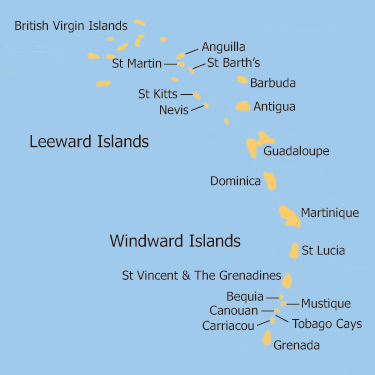 Grenada Destinations
Grenada Destinations
The islands of the Caribbean were shaped by volcanic activity thousands of years ago. The result is a chain of islands that stretch over 2,000 miles, with the Atlantic to the East and Caribbean Sea to the West.
Every Caribbean island has its own unique character shaped not only by its colourful history but also by its topography. From the unspoilt rainforest and black sandy beaches of Dominica to the European influenced St Kitts with its old plantation houses and glamorous hotels, all islands have something unique to offer.
Exploring the Caribbean by yacht is a wonderful way to appreciate the islands unique qualities and also enjoy the wonderful tropical climate. By day enjoy swimming through coral reefs, or going ashore and visiting anything from waterfalls to rum factories. Then by night try a new cuisine and experience island life before returning to your yacht for a well-deserved rest.
Miramar Sailing will help you tailor your dream Caribbean Sailing Vacation.
click on the island names for information
Windward Islands
![]() Martinique is sophisticated France in the Caribbean. The original capital of St Pierre was known as the ‘Little Paris of the West Indies’, but was wiped out by the island’s volcano ‘Mont Pelee’ in 1902, the volcano is still active today.
Martinique is sophisticated France in the Caribbean. The original capital of St Pierre was known as the ‘Little Paris of the West Indies’, but was wiped out by the island’s volcano ‘Mont Pelee’ in 1902, the volcano is still active today.
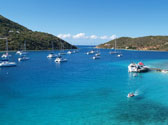 There is plenty of variety in Martinique. The northern end of the island is dense with lush rainforests with the south home to beautiful hidden bays. For water sports enthusiasts try surfing at Presqu’île de Caravelle, or diving at St Pierre where coral reefs and the ships wrecked from the devastation of the eruption of Mont Pelee can be explored. Cape Enrage boasts underwater caves that are home to a wide variety of marine life. The northern beaches have black sands but the waters can be dangerous, whereas the southern beaches are white and pristine with calm tropical waters.
There is plenty of variety in Martinique. The northern end of the island is dense with lush rainforests with the south home to beautiful hidden bays. For water sports enthusiasts try surfing at Presqu’île de Caravelle, or diving at St Pierre where coral reefs and the ships wrecked from the devastation of the eruption of Mont Pelee can be explored. Cape Enrage boasts underwater caves that are home to a wide variety of marine life. The northern beaches have black sands but the waters can be dangerous, whereas the southern beaches are white and pristine with calm tropical waters.
The hiking is varied like many volcanic islands with serious trails going up Mont Pelee. However there are gentler routes and organised hikes in Parc Naturel Regional.
St Pierre is a must to get an idea of what island life was like, explore the blackened ruins alongside new buildings. A visit to Musee Volcanologique will give you a good idea of the impact and devastation caused by the eruption of Mont Pelee, exhibiting artefacts pulled from the rubble. Out of town is Le Jardin des Pappillons, a beautiful garden and butterfly farm set up in the ruins of an old plantation.
For evening entertainment head to the bustling capital Fort-de-France and enjoy the restaurants and bars. Lorraine is the local beer, but also try the rums, the planteur punch and ti-punch are popular choices. Trois-Riveres Distillerie, and Depaz are worth a visit for tours of the rum distilleries.
In May each year, to mark the anniversary of the 1902 eruption a festival is held with live jazz and a candle lit procession. In August the Martinique Boat Race is held offering a week of yachting festivities.
![]() St Lucia is much more than the honeymoon destination it is renowned for. Of course, there are beautiful beaches and glamorous hotels, but the island also has a rich history and a landscape worth exploring.
St Lucia is much more than the honeymoon destination it is renowned for. Of course, there are beautiful beaches and glamorous hotels, but the island also has a rich history and a landscape worth exploring.
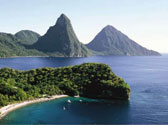 The different inhabitants have all left their mark, this is shown not just in the food and language but also the architecture. In Castries the capital, this is evident in the Cathedral of the Immaculate Conception, which is French in design, but with an African inspired interior and a negro Madonna and Child.
The different inhabitants have all left their mark, this is shown not just in the food and language but also the architecture. In Castries the capital, this is evident in the Cathedral of the Immaculate Conception, which is French in design, but with an African inspired interior and a negro Madonna and Child.
There are plenty of trails and hikes, the interior being made up of rainforest. The British colony was once covered in rainforest, sadly 90% of it was devastated by the timber industry, but what remains is now protected. An excellent series of cycle trails throughout the jungle offers a different perspective.
North of Castries is a big tourist area with rows of hotels. Further along the coast you have Rodney Bay, the Marina is popular with sailors and those who want to be seen. It offers restaurants, shops and banks and general St Lucia ‘glitz and glamour’. The beach is home to more hotels. If you would like to get to know the real St Lucia then stop off at the village of Gros Islet. This sleepy fishing village has wonderful local restaurants, albeit rustic. Nearby beaches are some of the best and they are not overcrowded or spoilt.
Marigot Bay in the South, was made famous for featuring in the 1967 film "Doctor Doolittle". The beautiful hidden bay is perfect for mooring and hiding away from the crowds. Soufriere was named by the French after the hot springs which were found nearby and are still a popular destination. However the Pitons are what really attracts visitors, the twin volcanic towers of rock are St Lucia’s famous landmark. For the adventurers they can be climbed, but a guide is recommended and it does take a day to summit each peak.
![]() St Vincent and the Grenadines are a beautiful chain of islands which embody everything that is Caribbean; beautiful tropical waters and picture post card islands. St Vincent was ‘discovered’ by Columbus in 1498 on the feast day of the Portuguese patron saint Vincent of Sargossa and so the island was named.
St Vincent and the Grenadines are a beautiful chain of islands which embody everything that is Caribbean; beautiful tropical waters and picture post card islands. St Vincent was ‘discovered’ by Columbus in 1498 on the feast day of the Portuguese patron saint Vincent of Sargossa and so the island was named.
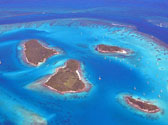 St Vincent itself is a good jumping off point for the other islands, but take the time to explore it. The capital Kingstown is busy with locals going about their business. The architecture harks back to colonial times, you can lose yourself wandering through the cobblestone streets.
St Vincent itself is a good jumping off point for the other islands, but take the time to explore it. The capital Kingstown is busy with locals going about their business. The architecture harks back to colonial times, you can lose yourself wandering through the cobblestone streets.
A trip to St Vincent Botanical Gardens is a wonderful oasis of tranquillity, established in 1762 they are the oldest botanical gardens in the western hemisphere. It is also home to an aviary housing the endangered St Vincent parrot.
The north of the island is in stark contrast to the more touristy south. Black sand beaches, banana plantations and rainforest are all to be found, with the towering, and still active, La Soufriere volcano dominating the horizon. Richmond beach boasts black sand and impressive coast. The interior offers hiking for all levels, the Vermont Nature Trails are a good starting point. Villages are unspoilt and give a flavour of life as an islander. Walliabou Bay and Falls have been made famous by the ‘Pirates of the Caribbean’ films. Much of the sets were left behind and make for an interesting tour.
Vincy Mas is the annual carnival in June and draws a big crowd. Parties, music, live performances and parades are a must see.
![]() Bequia is the first island you get to south of St Vincent. This beautiful little island was once on the trade route so is familiar and welcoming to visitors.
Bequia is the first island you get to south of St Vincent. This beautiful little island was once on the trade route so is familiar and welcoming to visitors.
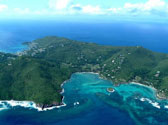 Port Elizabeth, popular with the yachting set, runs along Admiralty Bay, and hosts several shops, restaurants and bars. Fort Hamilton offers panoramic views of the bay and is still home to ancient canon that were used by the British in the 1700’s. Princess Margaret Beach is a beautiful stretch of sand to while away a few hours.
Port Elizabeth, popular with the yachting set, runs along Admiralty Bay, and hosts several shops, restaurants and bars. Fort Hamilton offers panoramic views of the bay and is still home to ancient canon that were used by the British in the 1700’s. Princess Margaret Beach is a beautiful stretch of sand to while away a few hours.
Lower Bay and Friendship Bay, are great places to tune into Caribbean time. Both are sleepy communities with a few restaurants and guest houses on offer.
A visit to the Old Hegg Turtle Sanctuary is informative and allows visitors to get up close to juvenile turtles. The Bequia Maritime Museum gives a wonderful insight into this boat building community, Whale boats and schooners were built in Bequia, and really put it on the map.
"Moon Hole" on the south west corner is a must see! Not only is there a hole in the rock face where at the right time of year you will see the moon rising through the hole, but the surrounding hill side has been carved out to create basic living accommodation linked by staircases. It is an amazing project!
The world famous Regatta takes place at Easter and brings in sailors from around the world.
![]() Mustique conjures up images of the rich and famous who want to get away from it all in paradise. However Mustique was not always so grand. In 1958 there were only 100 inhabitants left, following the European influence leaving the colony, those who stayed had to make a living out of fishing and farming. Fortunes changed when Colin Tennant bought the island and started to invest in its infrastructure, which led to the founding of the Mustique Company that still manages the island today. Sixty years on, the island you see now is a far cry from the shell that had been left from the plantation era.
Mustique conjures up images of the rich and famous who want to get away from it all in paradise. However Mustique was not always so grand. In 1958 there were only 100 inhabitants left, following the European influence leaving the colony, those who stayed had to make a living out of fishing and farming. Fortunes changed when Colin Tennant bought the island and started to invest in its infrastructure, which led to the founding of the Mustique Company that still manages the island today. Sixty years on, the island you see now is a far cry from the shell that had been left from the plantation era.
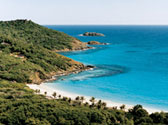 Several old buildings have been restored including the famous Cotton House which is now a boutique hotel. The island offers wonderful snorkelling and diving along with picturesque beaches.
Several old buildings have been restored including the famous Cotton House which is now a boutique hotel. The island offers wonderful snorkelling and diving along with picturesque beaches.
A visit to the famous ‘Basil’s Bar and Restaurant’ is a must, eat, drink and be merry under the thatched restaurant and, if you are lucky, you might rub shoulders with a celebrity or two!
![]() Canouan is an island of two halves. The Raffles Resort and Trump Casino dominate half the island, with privatised beaches offering the visitor so many conveniences, that they never leave the complex. The other half of the island remains unspoilt and quieter, so the independent traveller can enjoy the real Canouan without the Raffles price tag.
Canouan is an island of two halves. The Raffles Resort and Trump Casino dominate half the island, with privatised beaches offering the visitor so many conveniences, that they never leave the complex. The other half of the island remains unspoilt and quieter, so the independent traveller can enjoy the real Canouan without the Raffles price tag.
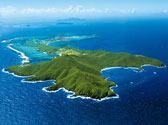 The name Canouan actually comes from the Amerindian name ‘Cannoun’ meaning turtle. Turtles can still be seen at certain times of the year coming ashore to lay their eggs on the sheltered windward beaches. Coastal walks allow the more intrepid visitor to admire the beaches and coves which are not accessible by road.
The name Canouan actually comes from the Amerindian name ‘Cannoun’ meaning turtle. Turtles can still be seen at certain times of the year coming ashore to lay their eggs on the sheltered windward beaches. Coastal walks allow the more intrepid visitor to admire the beaches and coves which are not accessible by road.
The Canouan Regatta in May/June is a festival both on and off the water; boat races, calypso competitions and all manner of festivities take place.
![]() Tobago Cays are, quite simply, breathtaking, consisting of 5 uninhabited islands each with its own coral reef halo. As a national park the islands remain unspoilt. The beaches and waters are out of this world and can be toured in a day. The authorities are keen to keep these cays in their pristine condition. Visitors are asked to be as ‘low impact’ as possible, this means taking away your garbage and using reputable tour guides.
Tobago Cays are, quite simply, breathtaking, consisting of 5 uninhabited islands each with its own coral reef halo. As a national park the islands remain unspoilt. The beaches and waters are out of this world and can be toured in a day. The authorities are keen to keep these cays in their pristine condition. Visitors are asked to be as ‘low impact’ as possible, this means taking away your garbage and using reputable tour guides.
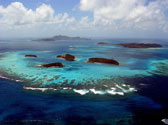 For divers the Mayreau Gardens are stunning coral reefs with a variety of marine life. The warm tropical waters make it even more delightful. The Baradal Turtle Sanctuary is home to the green and hawksbill turtle who can be seen in their natural environment. For those who want to stay above water the Catholic Bird Sanctuary is an excellent place to observe large colonies of sea birds nesting.
For divers the Mayreau Gardens are stunning coral reefs with a variety of marine life. The warm tropical waters make it even more delightful. The Baradal Turtle Sanctuary is home to the green and hawksbill turtle who can be seen in their natural environment. For those who want to stay above water the Catholic Bird Sanctuary is an excellent place to observe large colonies of sea birds nesting.
Petit Tabac has been made famous by the Pirates of the Caribbean-"Curse of the Black Pearl" film. It is also perfect for a picnic on your very own desert island. Petit Bateau, James Bay and Petit Rameau all offer hiking trails. Hikers can observe iguanas, birds and array of flora and fauna on route.
![]() Carriacou is known as the ‘Land of Reefs’ and is how the West Indies was before it was discovered by tourists. It is quiet, restful and full of the soul of Caribbean culture. The island offers wonderful hiking and secluded beaches, Anse La Roche is a hidden paradise which takes a bit of finding but is well worth the visit.
Carriacou is known as the ‘Land of Reefs’ and is how the West Indies was before it was discovered by tourists. It is quiet, restful and full of the soul of Caribbean culture. The island offers wonderful hiking and secluded beaches, Anse La Roche is a hidden paradise which takes a bit of finding but is well worth the visit.
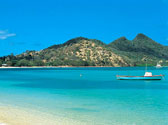 A visit to the Carriacou Museum offers an insight into island life through the ages. Artefacts dating back to the Amerindians, alongside relics from the French and British rules, can all be found here.
A visit to the Carriacou Museum offers an insight into island life through the ages. Artefacts dating back to the Amerindians, alongside relics from the French and British rules, can all be found here.
Carriacou is famous for traditional wooden boat building, a skill which can still be seen today on the beaches. This dates back to the 19th Century when Scottish boat builders settled on the island. Their legacy lives on in local names and boat building skills. The annual Carriacou Regatta is trying to install these skills and enthusiasm into the next generation.
The population, although small, is passionate about its heritage and traditions. This can be seen in the many unique customs still retained today.
![]() Grenada, is the ‘Isle of Spice’, and stands out in recent history for being devastated by Hurricane Ivan and the 1980’s US invasion, the hulks of abandoned Cuban beach landing craft can still be seen in Hogs Bay. The island has made tremendous rebuilding progress and is extremely welcoming to yachting cruisers.
Grenada, is the ‘Isle of Spice’, and stands out in recent history for being devastated by Hurricane Ivan and the 1980’s US invasion, the hulks of abandoned Cuban beach landing craft can still be seen in Hogs Bay. The island has made tremendous rebuilding progress and is extremely welcoming to yachting cruisers.
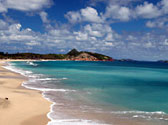 Grenada Island is the largest of the trio which make up ‘Grenada’ with Carriacou and Petit Martinique being the smaller sister islands. The capital St George’s is a mix of colonial and colourful Caribbean buildings. The European influence is ever present in the look and feel of the restaurants and shops. "Ivan" almost destroyed three 19th Century churches; work is still being done to bring them back to their former glory.
Grenada Island is the largest of the trio which make up ‘Grenada’ with Carriacou and Petit Martinique being the smaller sister islands. The capital St George’s is a mix of colonial and colourful Caribbean buildings. The European influence is ever present in the look and feel of the restaurants and shops. "Ivan" almost destroyed three 19th Century churches; work is still being done to bring them back to their former glory.
Grand Anse Beach is home to a strip of hotels catering for all budgets along the superb beach. However, created for tourists, it lacks any real heart. Further down the coast is Morne Rouge Bay which has a far superior beach but is not so popular with the masses.
Grand Etang Road cuts through the forest and gives a totally different aspect to the island. The rainforest boast monkeys, an African import as well as countless birds, reptiles and mammals. Clouds often hang on the mountains giving it a prehistoric feel. With a guide you can also find the spices growing wild which gave Grenada its name ‘Isle of Spice’. Alternatively visit ‘Laura’s Herb and Spice Garden’ for an educational tour of the plants, trees and spices.
Annandale Falls is a popular destination, but try to avoid cruise ship days. The 30ft waterfall drops into a beautiful grotto, surrounded by so much lush vegetation that it is easy to see why it is so popular.
The River Antoine Rum Distillery claims to be the oldest working water mill in the Caribbean and still produces rum to this day. A visit to the Gouyave Nutmeg Factory gives a fascinating introduction into the production of this spice.
To get even further off the beaten track head to Bathways Beach where three small uninhabited islands offer excellent swimming and snorkelling opportunities. Levera Beach is part of the national park scheme where the sea turtle is protected. This part of Grenada feels a world away from Grand Anse.
The cuisine is reflective of the country’s heritage, with the usual West Indian dishes. The national dish is ‘Oil down’ a thick meaty stew. French, Italian and Mexican influences can also be found.
Please see our Inter Island Options page for suggestions of which destinations can be included in a charter.